Cisco Network Convergence System: NCS 5500/5700 Modular Platform Architecture White Paper
Available Languages
Bias-Free Language
The documentation set for this product strives to use bias-free language. For the purposes of this documentation set, bias-free is defined as language that does not imply discrimination based on age, disability, gender, racial identity, ethnic identity, sexual orientation, socioeconomic status, and intersectionality. Exceptions may be present in the documentation due to language that is hardcoded in the user interfaces of the product software, language used based on RFP documentation, or language that is used by a referenced third-party product. Learn more about how Cisco is using Inclusive Language.
NCS 5500/5700 family introduction
The Network Convergence System (NCS) 5500/5700 Series is a family of routing platforms including fixed and modular chassis. The platforms offer high port density, high-performance forwarding, low jitter, and low power consumption at a very cost-effective price point.
The NCS 5500/5700 Series offers industry-leading density of routed 1/10/25/40/50/100/200/400G ports for high-scale WAN aggregation, core, and peering roles. It is designed to efficiently scale in support of data centers, large enterprises, web and service provider WAN, and aggregation networks.
The NCS 5500/5700 leverages the industry-leading IOS XR operating system with a full suite of standard layer 2 and layer 3 protocols plus new features and functions such as:
● Large label stack support
● Segment Routing/Segment Routing v6 and EVPN
● Comprehensive end-to-end OAM functionalities – including BFD, Ethernet OAM, Y.1731, Y.1564, and Ethernet loopback
● Application hosting
● Programmability
● Enhanced automation
● Machine-to-Machine interface (M2M)
● Telemetry
● Flexible package delivery
This white paper focuses on the hardware architecture, characteristics, and packet forwarding of the NCS 5500/5700 modular platforms.
NCS 5500/5700 modular platform architecture
The Cisco NCS 5500/5700 modular chassis series is available in three system sizes: NCS 5504, NCS 5508, and NCS 5516 for 4, 8, and 16 slots, respectively. Each of the chassis variants are highly reliable and resilient platforms, supporting a large range of line card options. The architecture is based on redundant route processors, system controllers, fabric modules, fan trays, and power supplies. All NCS 5500/5700 modular systems are built on the same principles and share common architecture components such as route processors, system controllers, power supplies, and line cards. The fan trays and fabric cards may vary between the platforms.
NCS 5504 platform
NCS 5504 is a 4-slot and 7 RU chassis.

NCS 5504 chassis front view and rear view
NCS 5508 platform
NCS 5508 is an 8-slot and 13 RU chassis.
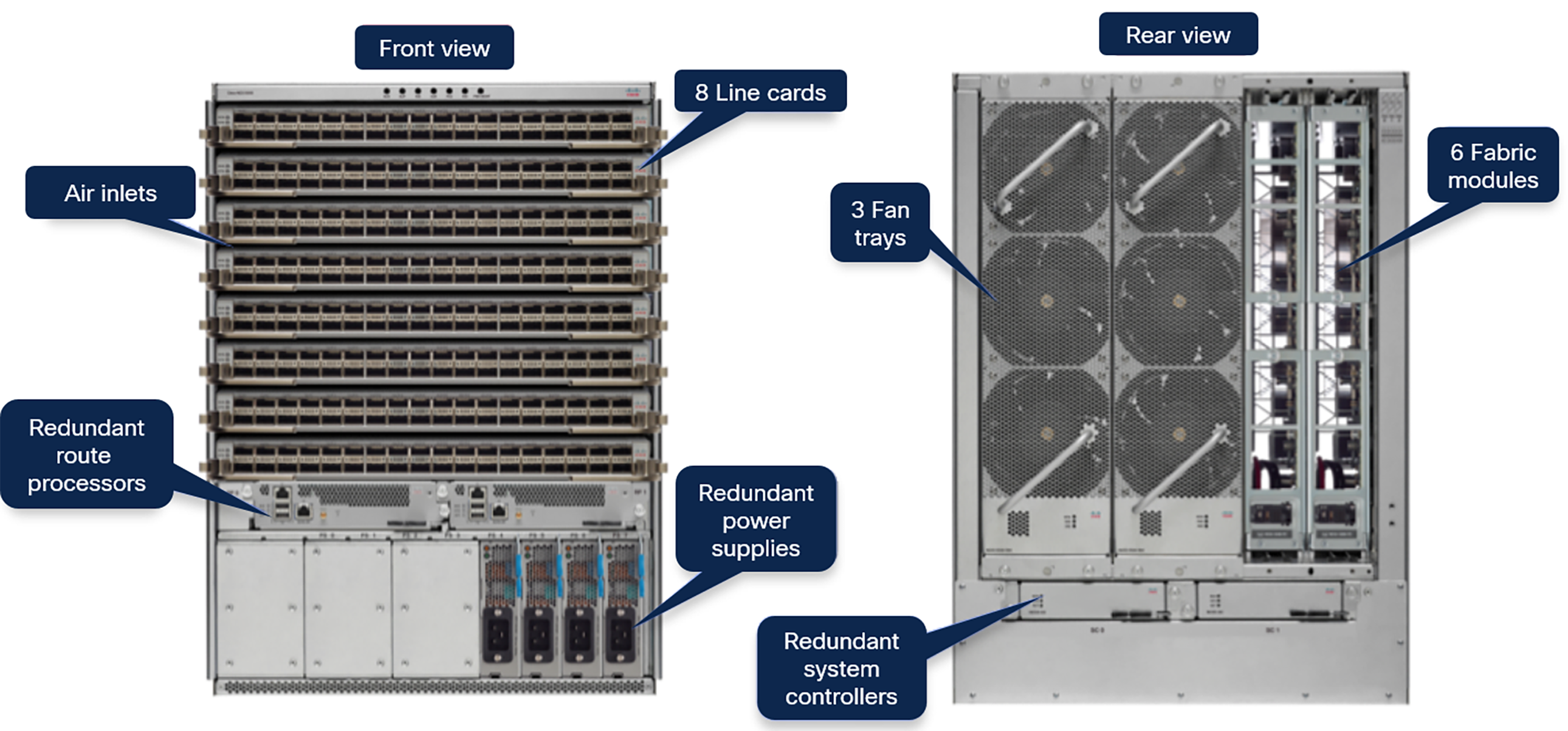
NCS 5508 chassis front view and rear view
NCS 5516 platform
NCS 5516 is a 16-slot and 21 RU modular chassis.
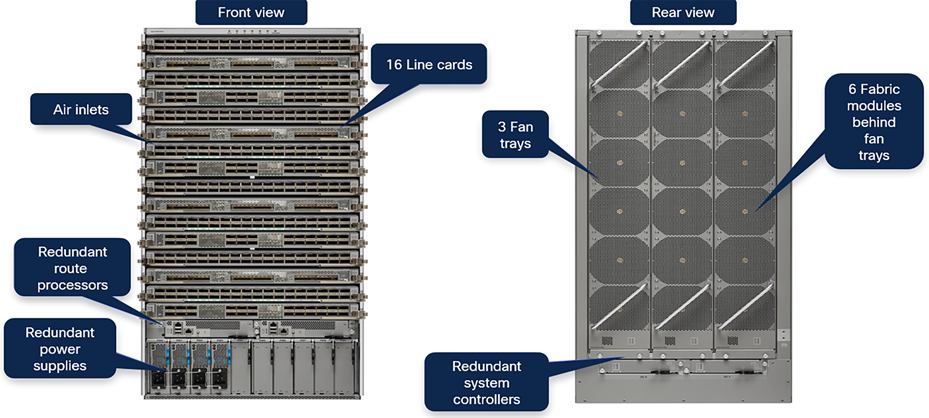
NCS 5516 chassis front view and rear view
In most traditional modular platform designs, a backplane or midplane provides connectivity between the line cards and fabric modules. The NCS 5500/5700 modular platform is based on Cisco’s innovative “orthogonal” chassis design that eliminates the need for a midplane in a modular chassis. With a precise alignment mechanism, NCS 5500/5700 modular router line cards and fabric modules directly attach to each other with connecting pins. Line cards and fabric modules have the orthogonal orientations in the chassis so that each fabric module is connected to all line cards and vice versa.
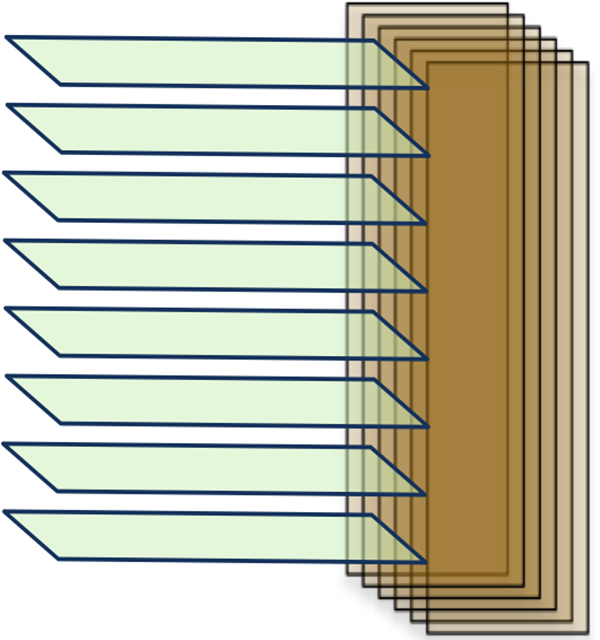
Orthogonal direct design
Eliminating the need for a midplane provides advantages such as compact chassis design, efficient airflow, and optimized cooling.
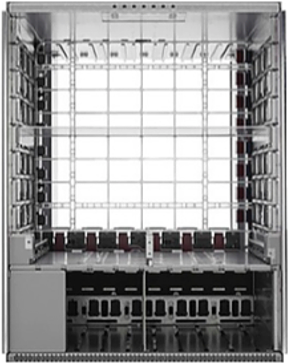
Mid-plane free chassis
NCS 5500/5700 chassis specifications
Table 1. NCS 5500/5700 modular platform specifications
| Specifications |
NCS 5504 |
NCS 5508 |
NCS 5516 |
| Chassis Height |
7 Rack Units |
13 RU – 1/3 of a Rack |
21 RU – 1/2 of a Rack |
| Chassis Dimensions (H x W x D) |
12.25 x 17.50 x 33.15 inches 31.1 x 44.50 x 84.20 cm |
22.70 x 17.50 x 31.76 inches 57.78 x 44.50 x 80.67 cm |
36.70 x 17.50 x 31.76 inches 93.41 x 44.50 x 80.67 cm |
| Line Card Slots |
4 Slots per Chassis |
8 Slots per Chassis |
16 Slots per Chassis |
| Route Processors |
2 (1+1 Redundant RPs) |
||
| System Controllers |
2 (1+1 Redundant SCs) |
||
| Fabric Modules |
6 Fabric Cards (5+1 Redundant) |
||
| Fan Trays |
3 Redundant Fan Trays |
||
| Air Flow |
Front-to-Back Airflow |
||
| Power Supplies |
4 x 3-kW/AC or DC PSUs Or 4 x 3.15-kW HVAC/HVDC Or 4 x 4.4-kW DC (supports N+1 and N+N Redundancy) |
8 x 3-kW AC or DC PSUs Or 8 x 3.15-kW HVAC/HVDC Or 8 x 4.4-kW DC (supports N+1 and N+N Redundancy) |
10 x 3-kW AC or DC PSUs Or 10 x 3.15-kW HVAC/HVDC Or 10 x 4.4-kW DC (supports N+1 and N+N Redundancy) |
| Max Port Density |
10G: 4 breakout x 36 ports x 4 slots = 576 40G: 36 ports x 4 = 144 100G: 36 ports x 4 = 144 400G: 24 ports x 4 = 96 |
10G: 4 breakout x 36 ports x 8 slots = 1152 40G: 36 ports x 8 = 288 100G: 36 ports x 8 = 288 400G: 24 ports x 8 = 192 |
10G: 4 breakout x 36 ports x 16 slots = 2304 40G: 36 ports x 16 = 576 100G: 36 ports x 16 = 576 400G: 24 ports x 16 = 384 |
| Max Throughput/ System |
38.4 Tbps (with 400G ports; 9.6T * 4) |
76.8 Tbps (with 400G ports; 9.6T * 8) |
153.6 Tbps (with 400G ports; 9.6T * 16) |
| Weight |
84 lb/38.2 kg |
150 lb/68.2 kg |
192 lb/87.3 kg |
The NCS 5500/5700 Series also supports the Cisco DDoS Edge Protection solution.
Add leading DDoS protection directly to the NCS 5500/5700 Series to detect and block DDoS attacks on-box cost-effectively at aggregation and peering locations.
Cisco DDoS Edge Protection is supported on the following platforms:
Distributed Platforms:
NCS 5504
NCS 5508
NCS 5516
Line Cards:
NC55-MOD-A-S
NC55-MOD-A-SE-S
NC55-32T16Q4H-A
NC55-32T16Q4H-AT
NC55-6X200-DWDM-S
NC55-36X100G-S
NC55-24X100G-SE
NC55-36X100G
NC55-18H18F
NC55-24H12F-SE
NC55-36X100G-A-SE
NC55-24DD
NC57-24DD
NC57-48Q2D-S
NC57-48Q2D-SE-S
NC55-18DD-SE
NC57-18DD-SE
NC57-36H6D-S
NC57-36H-SE
NC57-MOD-S
Learn more about Cisco DDoS Edge Protection.
Route Processor module
The Route Processor (RP) in the NCS 5500/5700 modular platform provides control plane functions while all the data plane functionality is moved to the line card and fabric modules. The NCS 5500/5700 modular platform supports redundant half-width route processors. There have been three generations of RPs: RP/RP-E/RP2-E. For all timing functions in a single modular chassis, we need both Jericho+/Jericho2 -based line cards and a pair of RP-E or RP2-E.
The NC55-RP-E is based on a newer generation Intel six-core CPU operating at 1.9 GHz with 32 GB of RAM and 240-GB Flash SSD storage. It provides two independent BITS ports, in/out – RJ48 connector port, and IEEE 1588 support: Copper 10/100/1000-Mbps RJ-45 Ethernet port, GPS ToD (RS422), 1-pps RS422 or 1.0/2.3 50-ohm RF connector, in/out, and 10-MHz 1.0/2.3 50-ohm RF connector, in/out.
Note: The NC55-RP is now End of Sale and NC55-RP-E will End of Sale in May 2024.
The NCS55-RP2-E is the third generation of the RPs. It is compatible with all the three modular form factors. It supports Class C timing. This will require all the line cards in the chassis to be Class C capable. With a mix of Class C and non-Class C line cards, the chassis falls back to Class B. It is supported from IOS XR 7.3.1.

Route processor NC55-RP-E

Route processor NC55-RP2-E
The NCS 5500/5700 can host two route processor modules, though only one route processor is active at a time. The other route processor operates in standby mode, ready to assume control if the primary fails, providing stateful switchover. RP-E and RP2-E are supported with both version-1 and version-2 Fans and Fabric cards.
The route processor’s high-speed multicore CPU and large memory base builds the foundation for a highly available platform and provides very fast convergence in case of failure. The route processor runs Cisco’s 64 - bit IOS XR operating system. The 64-bit IOS XR enables better processing performance and faster access to system memory. It also provides the ability to create containers to run third-party applications. These advantages plus the new feature enhancements such as telemetry, programmability, and flexible packaging in IOS XR builds a solid foundation for NCS 5500/5700 platforms.
Out-of-band management is available via a 10/100/1000-Mbps Management Ethernet interface and a serial RS-232 console port. There are two USB 2.0 interfaces that can be used for disaster recovery and also to transfer system images and logs. The communications between the route processor and the fabric modules or line cards utilize either Ethernet Out-of-Band Channel (EOBC) or Ethernet Protocol Channel (EPC). Both channels have a central hub on the system controllers providing redundant paths.
Table 2. NCS 5500/5700 route processor specifications
| Specifications |
NC55-RP |
NC55-RP-E |
NC55-RP2-E |
| Processor |
Intel Ivy Bridge-EN 6-Core @ 2.2 GHz |
Intel Broadwell-DE 6-Core @ 1.9 GHz |
|
| System Memory |
24 GB DRAM |
32 GB DRAM |
|
| Flash Storage |
256 GB Flash SSD Storage |
240 GB Flash SSD Storage |
|
| Out-of-Band Management |
10/100/1000-Mbps Management Ethernet Port |
||
| Console Port |
1 x RS-232 Serial port |
||
| USB Interface |
2 x USB 2.0 slots |
||
| Timing |
N/A |
Class B Timing Interface BITS: RJ48 connector ports IEEE 1588: RJ-45 Ethernet port ToD (RS422) 1-pps RS422 or 1.0/2.3 50-ohm RF connector, in/out 10-MHz 1.0/2.3 50-ohm RF connector, in/out |
Class B and Class C Timing Interface BITS: RJ48 connector ports IEEE 1588: RJ-45 Ethernet port ToD (RS422) 1-pps RS422 or 1.0/2.3 50- ohm RF connector, in/out 10-MHz 1.0/2.3 50-ohm RF connector, in/out |
Route processor – line card timing compatibility matrix
The following table summarizes the timing support for Class B or Class C with respect to the route processor installed.
Table 3. NCS 5500/5700 RP/LC timing compatibility matrix
| Line Card combination |
RP-E (Class B) |
RP2-E (Class C) |
| All LC in chassis: Class B capable |
Entire chassis: Class B |
Entire chassis: Class B |
| All LC in chassis: Class C capable |
Entire chassis: Class B |
Entire chassis: Class C |
| Mixed Class B and Class C LC in chassis |
Entire chassis: Class B |
Entire chassis: Class B |
Note: RP-E with RP2-E in the same chassis is not supported.
System controller module
The system controller of the modular platform offloads the chassis control and management functions from the route processor module. The system controller is based on a dual-core ARM CPU operating at 1.3 GHz. It provides intra-chassis communication between the hardware components as well as a central point of control for the fans, power supplies, and other hardware elements in the modular chassis.
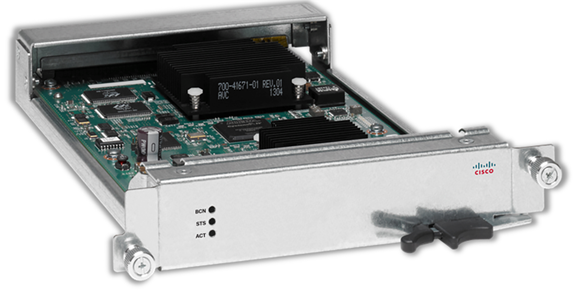
NCS5500/5700 modular platform system controller
For the intra-chassis communication, there are two main logically isolated control and management communication paths: Ethernet Out-of-Band Channel (EOBC) and Ethernet Protocol Channel (EPC).
Ethernet Out-of-Band Channel (EOBC)
EOBC is a 1/2.5/10Gbps[1] switch for inter-process communication or device management in NCS 5500/5700 modular platforms.
All system management communication across modules takes place through the EOBC channel. The EOBC channel is provided via a switch chipset on the system controllers that inter-connects all modules together, including route processors, fabric modules, and line cards.
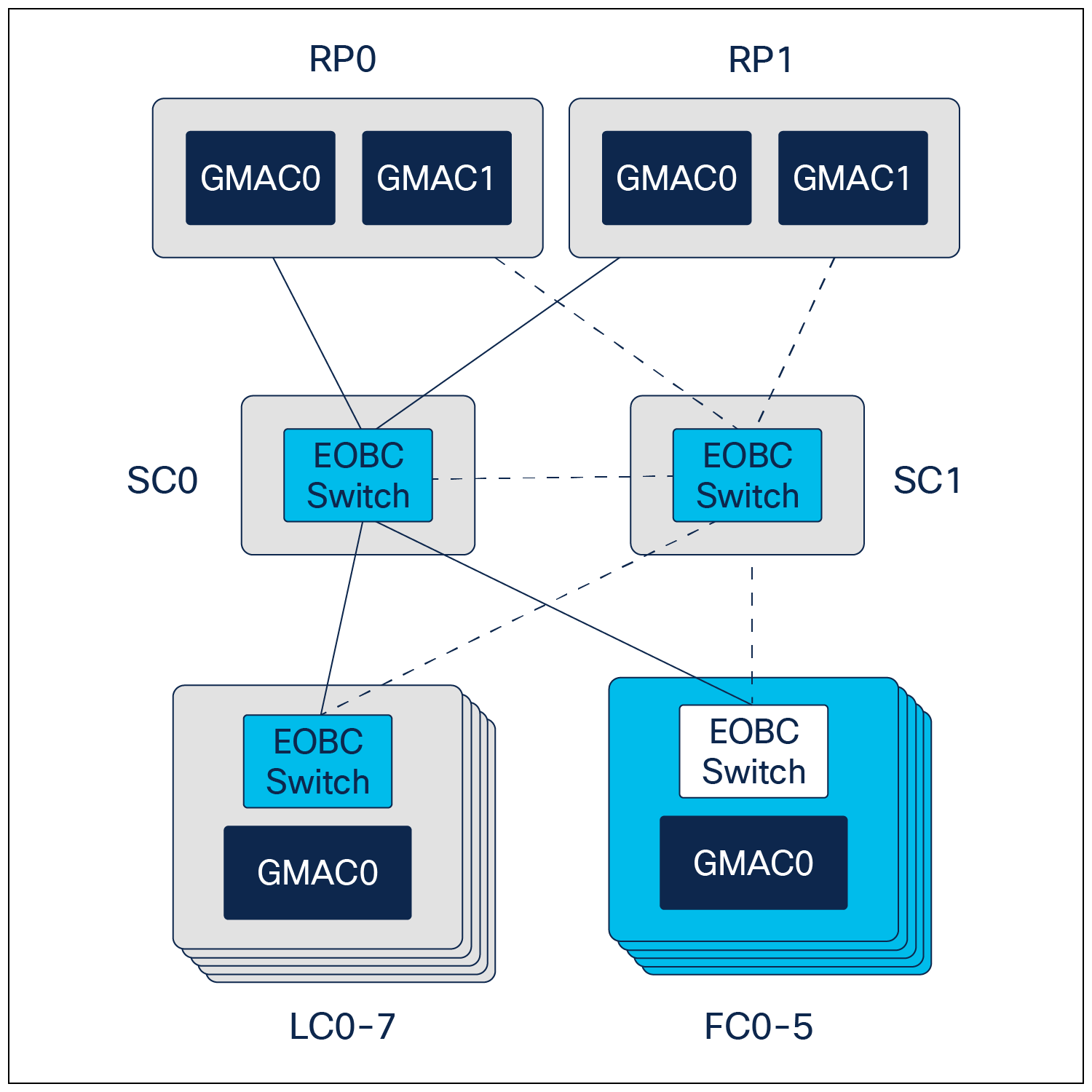
EOBC network
Ethernet Protocol Channel (EPC)
EPC is a 1/2.5/10Gbps switch for intra-node data plane protocol communications. Unlike the EOBC channel, the EPC switch only connects fabric modules to route processors. It is responsible for sending control plane packets to the route processor or to the line card CPU. If protocol packets need to be sent to the route processor, line cards utilize the internal data path to transfer packets to fabric modules. The fabric modules then redirect the packet via the EPC channel to the route processors.
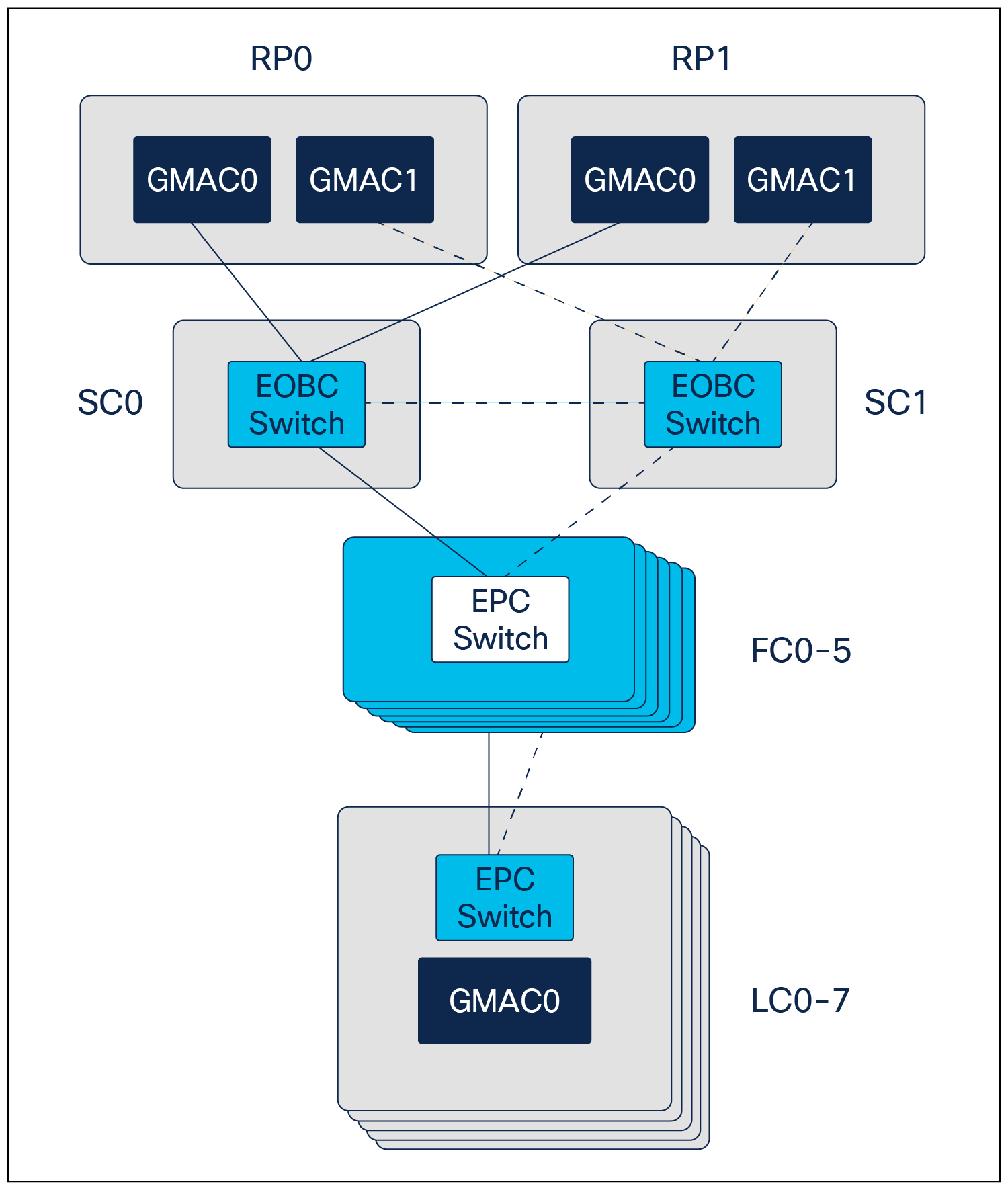
EPC network
The system controller also communicates with, and manages, power supply units and fan controllers via the redundant System Management Bus (SMB). The NCS 5500/5700 modular platforms support redundant system controllers. Only one system controller will be active at a time in a chassis. The second system controller will assume the secondary or standby role to provide redundancy.
Power supplies
The NCS 5500/5700 modular platform power supply modules deliver fault tolerance, high efficiency, load sharing, and hot-swappable features to the platform. The power supplies are platinum-rated and offer 92% plus efficiency, so less power is dissipated as heat and more power is available for the system to use than with typical power supplies. They are also RoHS compliant. The power supplies provide internal component-level monitoring, temperature sensors, and intelligent remote-management capabilities.
Four PSU options are available today:
3000W AC, single feed
3000W DC can accept a single or dual DC input source; it will deliver 1.5 kW when only one input is active and 3 kW when two inputs are active.
3150W “universal” power supply: dual-feed AC or dual-feed HVDC, depending on the cable used
4400W DC can accept a single, dual, or triple DC input source; it will deliver 2.2 kW when only one input is active and 4.4 kW when two or three inputs are active at 12VDC output.
All power supplies in a system must be of the same type. The number of supported and necessary PSU depends on the chassis type.
NCS 5504 chassis can accommodate up to four power supply modules, while only three are necessary to provide N+1 redundancy for a chassis fully loaded with the highest power line cards. NCS 5508 chassis can accommodate up to eight power supply units, though only five are required to provide N+1 redundancy for a fully loaded chassis. NCS 5516 chassis can accommodate 10 power supplies, while only eight power supplies are required for N+1 redundancy.

3kW AC power supply

3kW DC power supply
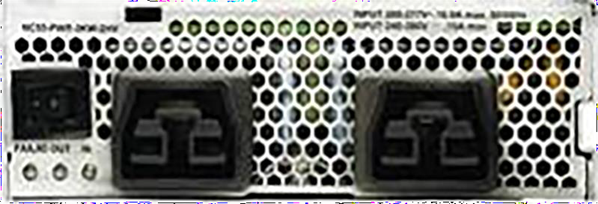
3.15kW universal power supply

4.4kW DC power supply
Table 4. NCS 5500/5700 modular platform AC and DC power supply specifications
|
|
3kW AC PSU |
3kW DC PSU |
3.15kW Universal PSU |
4.4kW DC |
| Voltage |
210V to 264V |
-48V to -60V |
180V to 305V (AC), 192V to 400V (DC) |
-48V to -60V |
| Output Power |
3000 Watts |
3000 Watts |
3150 Watts |
4400W |
| Efficiency |
Platinum-rated power supply with 92% efficiency |
|||
| PSU per Chassis |
NCS 5504: 4 PSU max NCS 5508: 8 PSU max NCS 5516: 10 PSU max |
|||
Modular fan trays
NCS 5500/5700 chassis can host three redundant hot-swappable fan trays. The fan trays support front-to- back air flow and adjust speed accordingly to compensate for changing ambient temperature and fan failures. The fan modules are not common between the 5504, 5508, or 5516 platforms and cannot be used interchangeably:
Each NCS 5504 fan tray is made of two fans.
Each NCS 5508 fan tray is made of three fans.
Each NCS 5516 fan tray is made of six fans.
The fan trays are installed behind the fabric modules in the back of the chassis. Each fan tray “covers” two fabric cards.
Fan trays must be removed in order to service the fabric modules. As soon as the fan tray is removed, the remaining fans increase the speed to 100% to prevent overheating. This operation needs to be completed in approximately two minutes (according to the hardware installation guide). The fan controllers actively monitor system temperatures and adjust the fan speeds within a range of 3300 to 6500 RPM. Two versions of fan trays exist. The new-generation NC55-55xx-FAN2 is required to support second-generation NC55-55xx-FC2 fabric cards and NCS5700 line cards; v2 fan trays are compatible with NCS5500 and NCS5700 line cards running with v2 fabric cards, but v1 fan trays are only supporting NCS5500 line cards with v1 fabric cards.
Table 5. NCS 5500/5700 fan trays and fabric cards interoperability
| Fan Trays |
NC55-55xx-FC Fabric Cards |
NC55-55xx-FC2 Fabric Cards |
| NC55-55xx-FAN Fan Trays |
Yes |
No |
| NC55-55xx-FAN2 Fan Trays |
No |
Yes |
Table 6. NCS 5500/5700 fan tray v1 specifications
| Inlet Temperature |
PWM |
NCS 5504 Acoustic |
Power per FT |
NCS 5508 Acoustic |
Power per FT |
NCS 5516 Acoustic |
Power per FT |
| <30°C |
5% |
71 dB |
37-40 W |
75 dB |
55-60 W |
75 dB |
110-120 W |
| 30 – 40°C |
35% |
82 dB |
113-120 W |
85 dB |
170-180 W |
88 dB |
340-350 W |
| >40°C |
100% |
89 dB |
187-193 W |
91 dB |
280-290 W |
94 dB |
560-580 W |
Table 7. NC55-55xx-FAN2 fan tray specifications
| Inlet Temperature |
PWM |
NCS 5508 Acoustic |
Power per FT |
NCS 5516 Acoustic |
Power per FT |
| <30°C |
55% |
85 dB |
170-180 W |
88 dB |
340-350 W |
| 30 – 40°C |
75% |
92.5 dB |
450-470 W |
95.5 dB |
900-950 W |
| >40°C |
90% |
96 dB |
750 W |
99 dB |
1500 W |
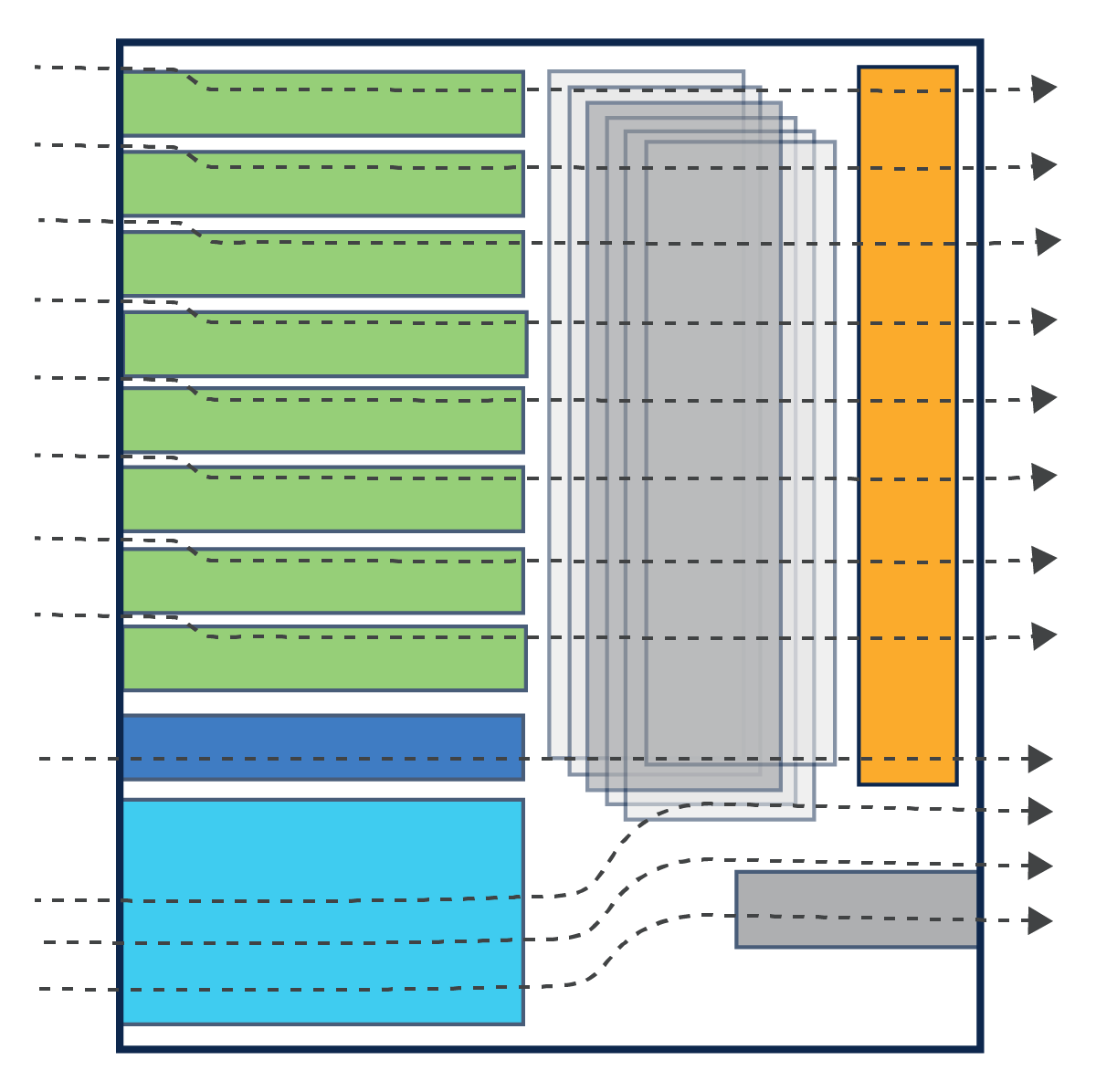
NCS 5508 front to back airflow example
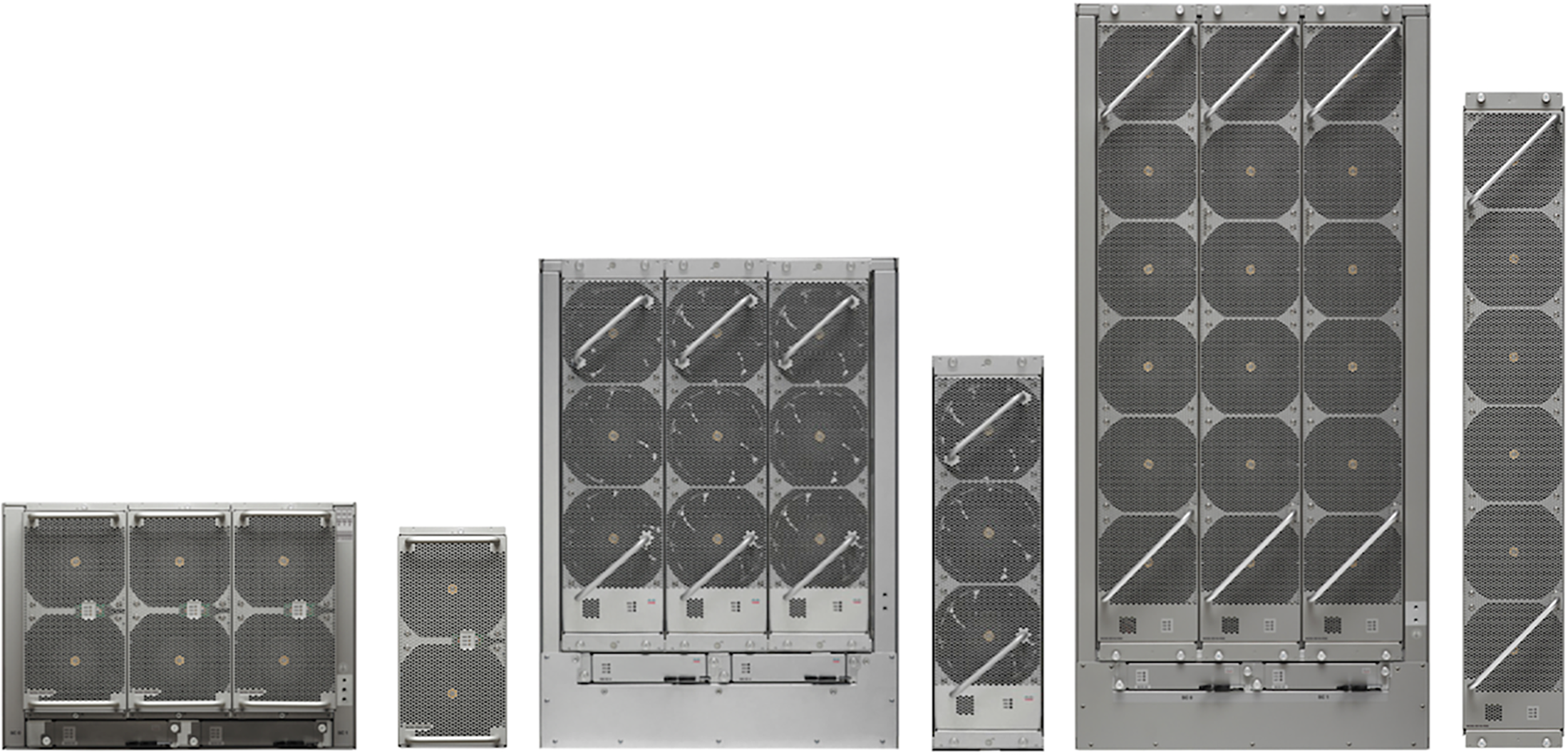
NCS 5504, NCS 5508, and NCS 5516 fan trays
Fabric Modules
The Cisco NCS 5500/5700 modular chassis has a Clos fabric design that interconnects the line cards with rear- mounted fabric modules. The fabric modules provide the central switching elements for fully distributed forwarding on the line cards. The platform supports up to six fabric modules, and all are directly connected to all line cards. The addition of each fabric module increases the bandwidth to all module slots up to the system limit of six modules.
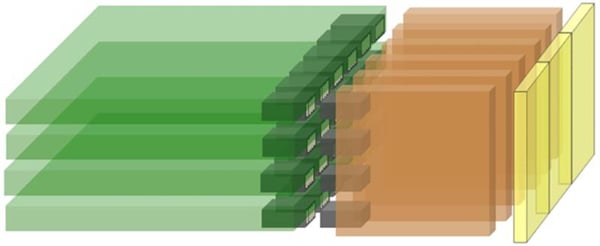
Fabric cards between line cards and fan trays
The architecture supports fabric redundancy, with the remaining fabric modules load balancing the bandwidth to all the line card slots, helping ensure progressive degradation. The fabric modules are not common for NCS 5504, NCS 5508, and NCS 5516 chassis and different sizes and cannot be used interchangeably. Two generations of fabric cards are available based on different fabric engines:
● v1 NC55-55xx-FC can be used with Jericho and Jericho+-based line cards.
● v2 NC55-55xx-FC2 can be used with all line cards, including the Jericho2-based ones.
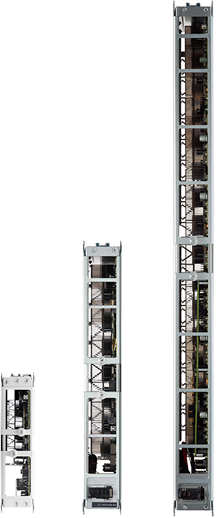
NCS 5500/5700 chassis fabric modules
Inside each of the fabric modules there are fabric ASICs called Switch Fabric Elements (SFEs), also referred to as fabric engines. First-generation fabric cards are powered by one or multiple FE3600 ASICs. The second generation are using FE9600 (Ramon) ASICs. The second generation requires a minimum IOS XR version: 6.6.3. As mentioned in the fan trays section, matching version is mandatory: v1 fan trays with v1 fabric cards and v2 fan trays with v2 fabric cards. The number of SFE per fabric card depends on the generation (v1 vs. v2) and the chassis type:
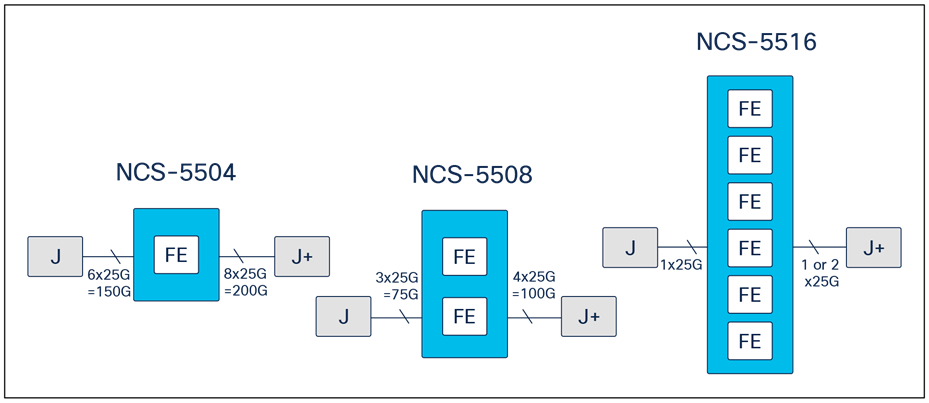
SFEs in v1 fabric cards
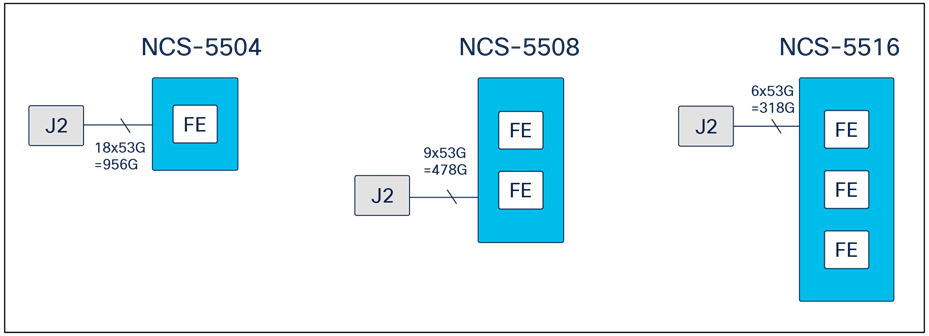
SFEs in v2 fabric cards
FE3600 and Ramon use 25G SERDES to connect to Jericho and Jericho+ NPUs while only Ramon SFEs can use 53G SERDES to connect to Jericho2 NPUs. The line cards and fabric modules perform cell-based forwarding via SFEs. When a packet comes in a line card and must get switched through the fabric module, the packet is segmented into smaller-sized cells (64 to 256 bytes) sent evenly across fabric cards. This round-robin approach to distribute cells to all the available fabric cards provides the required data path bandwidth and packet forwarding capacity to achieve a true non-blocking architecture. It also permits the router to forward single flows with no bandwidth limitation.
NCS5500/5700 Platform Line Cards
The NCS 5500/5700 chassis supports various types of line cards to provide 10G, 25G, 40G, 50G, 100G, 200G, and 400G data speeds, based on Ethernet and non-Ethernet terminations. Each chassis can accept line cards of different types as long as basic requirements are respected (for instance, the Jericho2-based line cards offering 400G connectivity require the use of v2 fabric cards and fan trays). It’s possible to mix and match all line card types.
Different optics are natively supported depending on the type of line cards:
● DP04QSDD-HE0*, QDD-400G-ZR-S, QDD-400G-ZRP-S, QDD-400G-FR4-S/DR4-S/LR8-S/LR4-S
● QDD-4X100G-FR-S, QDD-4X100G-LR-S
● QDD-400-CU1M/2M/3M
● SFP/SFP+/SFP28
● QSFP+/QSFP28
● QSFP28-DD/QSFP56-DD
● CFP2-DCO
Also, different breakout options are or will be supported:
● QSFP+: 4x10G
● QSFP28: 4x25G
● QSFP28-DD: 2x100G
● QSFP56-DD: 4x100G
● (* - Roadmap Items)
These ports can be mixed and matched in the same line cards.[2] The line cards also have a built-in ATOM CPU to offload some control plane tasks from the route processor, improving the control plane performance:
● Programming the hardware table resources
● Collecting/sending line card counters and statistics
● Processing BFD and ICMP packets
Each line card performs packet forwarding using one or more Forwarding ASIC (FA). The exact number and type vary per card and are detailed below. These FAs utilize a combination of on-chip and off-chip buffers to provide high performance at low power while allowing for up to 50 ms of buffering when congested. Each line card is powered by one or more than one ASIC. It could be Jericho, Jericho+, or Jericho2. Traffic destined for a different line card or different forwarding ASIC are distributed across the six fabric modules, while traffic targeted to a port located on the same FA will be switched/routed locally. The table below summarizes the available line cards in the portfolio as of today.
Table 8. NCS 5500/5700 modular line cards summary
| Hardware |
Forwarding Capacity |
Port Density |
MACsec |
Timing (With RP2-E) |
| NC57-24DD |
9.6 Tbps |
24x400G |
No |
Class B |
| NC57-18DD-SE |
7.2 Tbps |
18x400G or 30x200/100G |
No |
Class B |
| NC57-36H6D-S |
4.8 Tbps |
24x100G + 12 flex ports (6x400GE or 12x200GE/100GE) |
Yes |
Class C |
| NC57-36H-SE |
3.6 Tbps |
36x100G |
No |
Class B |
| NC57-MOD-S |
2.8 Tbps |
Fixed: 2x400G QSFPDD+ 8x10/25/50G SFP56 2X MPA: 2x400G or 12x50G |
Yes |
Class C |
| NC57-48Q2D-S |
2.4 Tbps |
2x400G QSFPDD + 16x1/10/25/50G SFP56* + 32x1/10/25G SFP28 |
Yes |
Class C** |
| NC57-48Q2D-SE-S |
2.4 Tbps |
2x400G QSFPDD + 16x1/10/25/50G SFP56* + 32x1/10/25G SFP28 |
Yes |
Class C** |
| NC55-36X100-A-SE |
3.6 Tbps |
36x100/40G |
No |
Class B |
| NC55-MOD-A (-SE)-S |
900 Gbps |
Fixed: 12x1/10G SFP/SFP+ 2x40G QSFP+ 2X MPA: 2x400G or 12x50G |
Yes |
Class B |
| NC55-32T16Q4H-A |
900 Gbps |
32x1/10GE SFP/SFP+ 16x10/25GE SFP+/SFP28 4x40/100GE QSFP+/QSFP28 (oversubscribed) |
Yes |
Class C |
NCS 5700 24x 400G Base Line Card
The NC57-24DD line card supports 24x400GE interfaces based QSFP-DD form factor and backward compatible with QSFP28 and QSFP+.
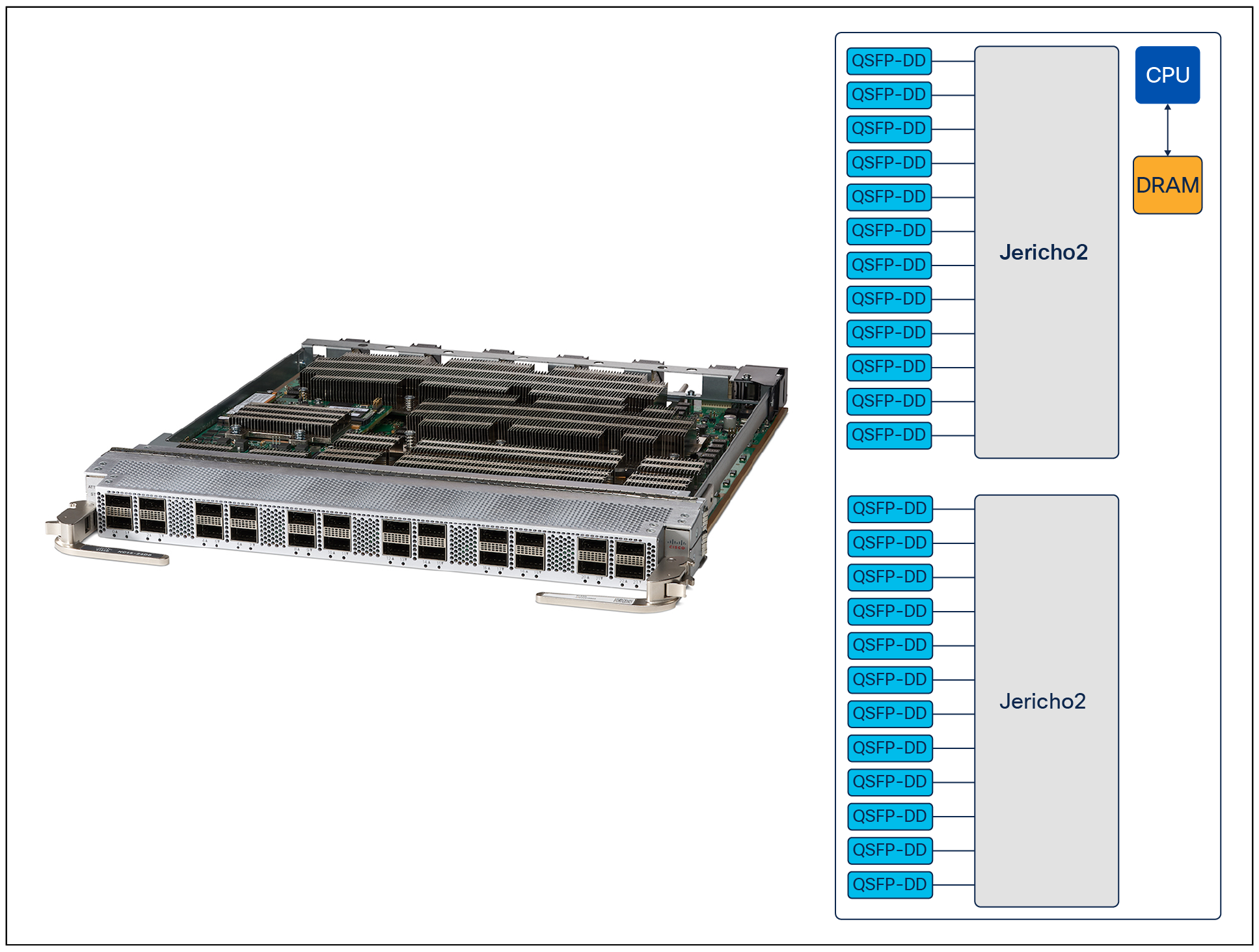
NCS 5700 24x400G base line card
It contains two Jericho2 forwarding ASICs, each offering 4800 Gbps of bandwidth with 2000 Mpps of throughput.
Table 9. NCS 5700 24x 400G line card specifications
| NC57-24DD |
Specifications |
| Ports |
24x QSFP-DD Ports |
| Forwarding ASICs |
2 Forwarding ASICs x (4800 Gbps bandwidth each) |
| Resources |
2.32M IPv4 Routes |
| Buffers |
32-MB On-chip Buffers 8-GB Off-chip Buffers |
| Packet Forwarding Rate |
Up to 4000 Mpps (2x 2000 Mpps) |
| NC57-24DD |
Specifications |
| Forwarding Throughput |
9.6 Tbps |
| Power Consumption |
Line card without any transceivers: Typical: 891 watts / Maximum: 986 watts |
NCS 5700 18x 400G + 12x 200G Scale Line Card
This line card is a scaled version of the 400GE line cards with next-generation external-TCAM, offering a mix of native 400G ports and 200G/2x100G/100G options.
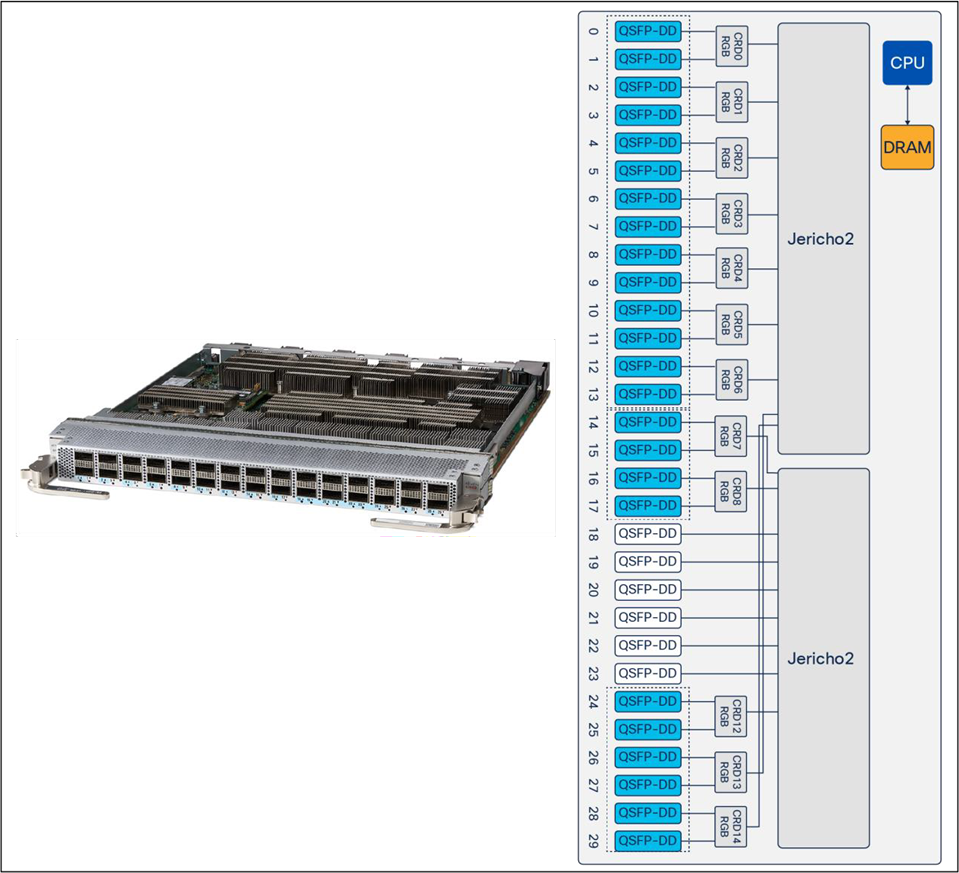
NCS 5700 18x 400G + 12-port 200G scale line card
Contains two Jericho2 forwarding ASICs, each offering 4800 Gbps of bandwidth with 2000 Mpps of throughput.
Table 10. NCS 5700 18x 400G + 12x 200G scale line card specifications
| NC57-18DD-SE |
Specifications |
| Ports |
18x400G or 30x200G/100G Ports: 6 native 400 Gbps 12 flex port pairs with QSFP-DD Breakout options available |
| Forwarding ASICs |
2 Forwarding ASICs x (4800 Gbps bandwidth each) |
| Resources |
5M IPv4 Routes |
| Buffers |
32-MB On-chip Buffers 8-GB Off-chip Buffers |
| Packet Forwarding Rate |
Up to 4000 Mpps (2x 2000 Mpps) |
| Forwarding Throughput |
7.2 Tbps |
| Power Consumption |
Line card without any transceivers: Typical (27°C): 860 watts / Maximum (40°C): 938 watts |
NCS 5700 36x100 Base Line Card
NC57-36H6D is the base version of the 100GE line cards with 36 QSFP-DD ports supporting 24 ports of QSFPDD 100G and 12 Flex Ports (6x400G or 12x100G/200G).

NCS 5700 36x 100G base line card
It contains a single Jericho2 forwarding ASIC offering 4800 Gbps of bandwidth with 2000 Mpps of throughput and supports MACSEC and Class C timing on all ports.
Table 11. NCS 5700 36x100G base line card specifications
| NC57-36H6D-S |
Specifications |
| Ports |
24x QSFP28 + 12 QSFP-DD Ports |
| Forwarding ASICs |
4800 Gbps |
| Resources |
2.32M IPv4 Routes |
| Buffers |
32-MB On-chip Buffers 8-GB Off-chip Buffers |
| Packet Forwarding Rate |
Up to 2000 Mpps |
| Forwarding Throughput |
4.8 Tbps |
| Power Consumption |
Line card without any transceivers: Typical (27°C): 674 watts / Maximum (40°C): 740 watts |
NCS 5700 36x100 Scale Line Card
NC57-36H-SE is the scaled version of the 100GE line cards based with 36 ports supporting 24 ports of QSFP28 100G and 12x100G QSFP-DD.
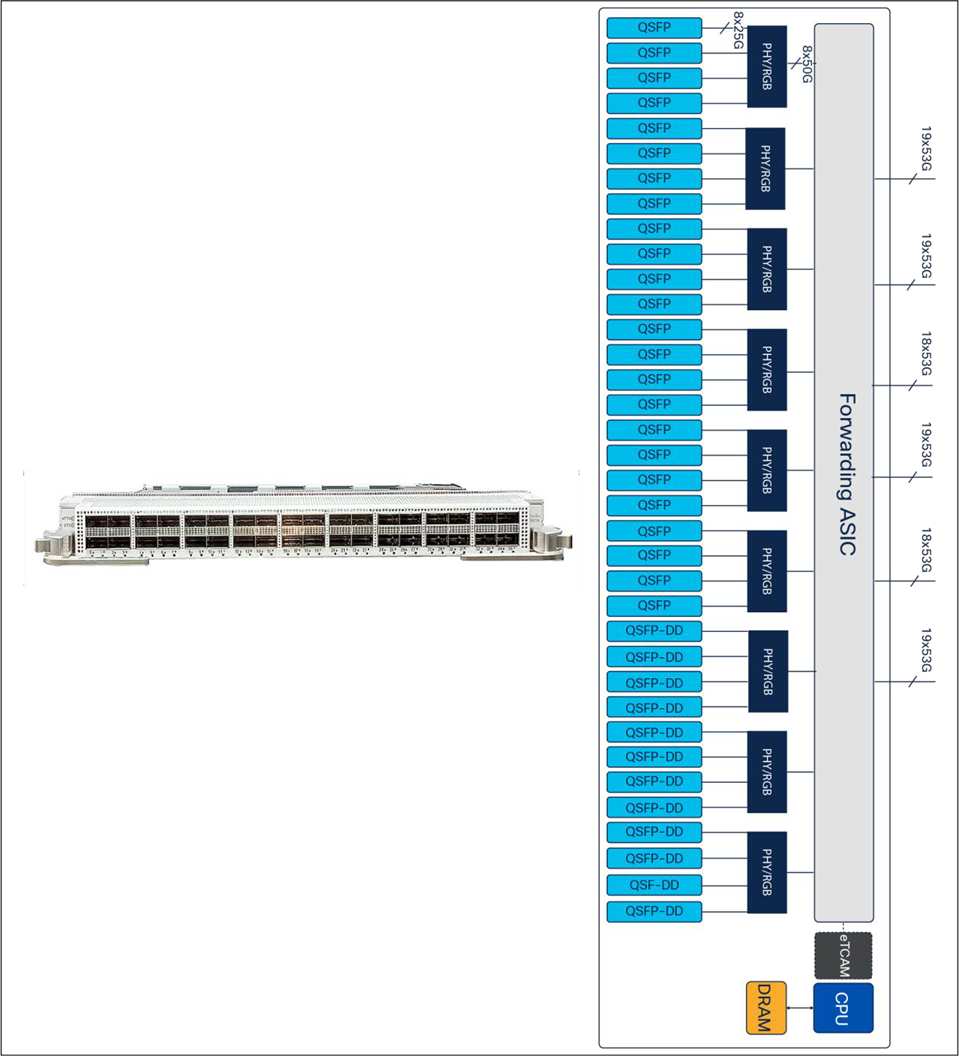
NCS 5700 36x 100G scale line card
It contains single Jericho2 forwarding ASIC Jericho2 offering 4800 Gbps of bandwidth with 2000 Mpps of throughput.
Table 12. NCS 5700 36x100G scale line card specifications
| NC57-36H-SE |
Specifications |
| Ports |
24 Ports QSFP28 12 Ports QSFP-DD in 100GE mode |
| Forwarding ASICs |
1 Forwarding ASICs 4800 Gbps bandwidth |
| Resources |
5M IPv4 Routes |
| Buffers |
32-MB On-chip Buffers 8-GB Off-chip Buffers |
| Packet Forwarding Rate |
Up to 2000 Mpps |
| Forwarding Throughput |
3.6 Tbps |
| Power Consumption |
Line card without any transceivers: Typical (27°C): 581 watts / Maximum (40°C): 618 watts |
NCS 5700 Modular Base Line Card
NC57-MOD-S is a modular line card available only in Base version. It is based on Jericho2 ASIC. It is the successor of the NC5500 modular Line card. It offers a mix of fixed QSFP-DD and SFP56 ports and two modular MPAs with support for MACSEC and Class C timing to support network use cases like Mobile xhaul, Aggregation, IPoEoF, Metro DCI, and Long-Haul DWDM applications. It supports native 25G/50G ports to support 5G xhaul use cases.
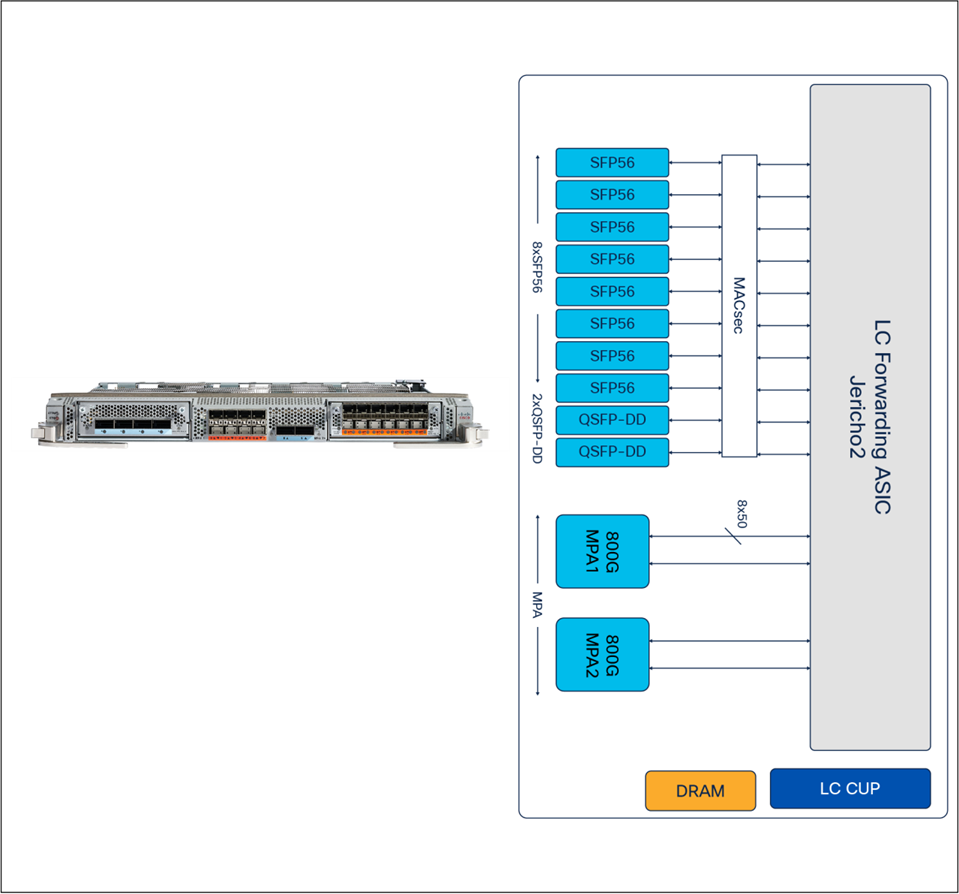
NC57-MOD-S base line card
Table 13. NCS 5700 MOD base line card specifications
| NC57-MOD-S |
Specifications |
| Ports |
2x MPAs (800G) + 8x SFP56 + 2x QSFP-DD |
| Forwarding ASICs |
1 Forwarding ASICs x (4.8 Tbps Full Duplex) |
| MACsec Capability |
IEEE 802.1AE standards-based Layer 2 hop-by-hop line rate encryption on all ports |
| Resources |
2.5M IPv4 routes |
| Buffers |
3-MB On-chip Buffers 8-GB Off-chip Buffers |
| Packet Forwarding Rate |
2000 Mpps |
| Forwarding Throughput |
4.8 Tbps |
| Power Consumption |
Line card without any transceivers and MPAs: Typical (27°C): 257 watts / Maximum (40°C): 281 watts |

MPAs supported on NC57-MOD-S
NCS 5700 Aggregation Line Card
NC57-48Q2D-S and NC57-48Q2D-SE-S are aggregation line cards available in base and scale versions respectively. They are built on a single Jericho2c ASIC and introduce native 1GE support on Jericho2 based modular systems. They provide a high density of SFP28 and SFP56 ports in addition to two 400G QSFP-DD ports. They provide MACsec and Class C timing support and are ideal for low-speed aggregation use cases for mobile xHaul.
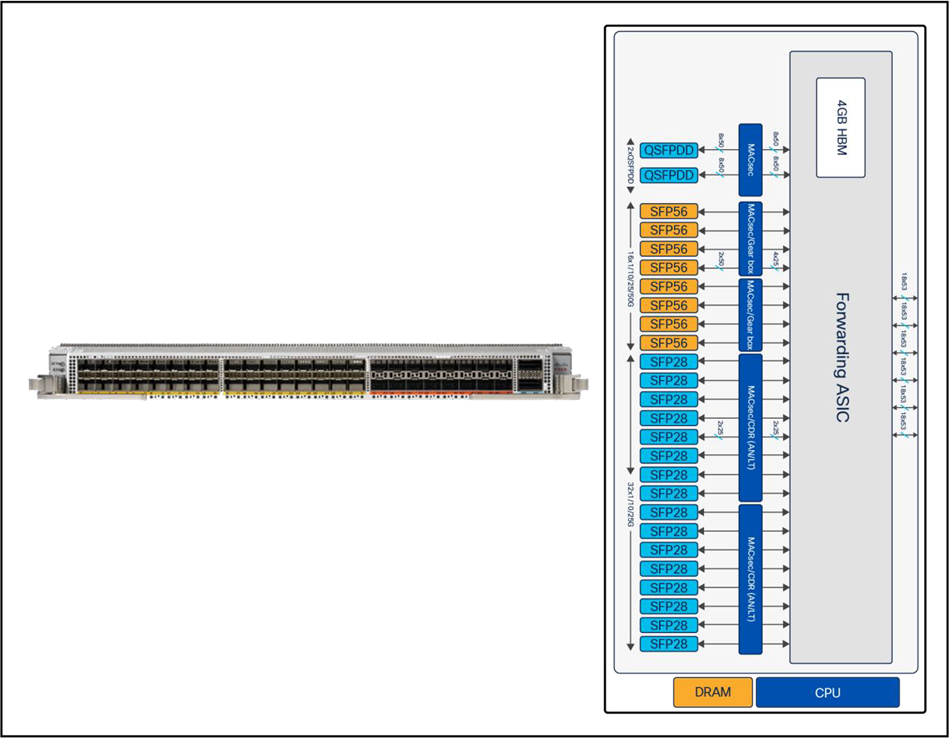
NC57-48Q2D-S Line Card
Table 14. NC57-48Q2D-S line card specifications
| NC57-48Q2D-S |
Specifications |
| Ports |
● 2 ports 400/100/40 Gigabit Ethernet
● 16 ports 1/10/25/50 Gigabit Ethernet
*
● 32 ports 1/10/25 Gigabit Ethernet
|
| Forwarding ASICs |
1 Forwarding ASIC x (2.4 Tbps bandwidth) |
| Resources |
2.32M IPv4 Routes |
| Buffers |
16-MB On-chip Buffers 4-GB Off-chip Buffers |
| Packet Forwarding Rate |
1000 Mpps |
| Forwarding Throughput |
2.4 Tbps |
*SW support for 1GE on SFP56 ports will be available in a future IOS XR release

NC57-48Q2D-SE-S Line Card
Table 15. NC57-48Q2D-SE-S line card specifications
| NC57-48Q2D-SE-S |
Specifications |
| Ports |
● 2
ports
400/100/40
Gigabit
Ethernet
● 16
ports
1/10/25/50
Gigabit
Ethernet
*
● 32
ports
1/10/25
Gigabit
Ethernet
|
| Forwarding ASICs |
1 Forwarding ASIC x (2.4 Tbps bandwidth) |
| Resources |
5M IPv4 Routes |
| Buffers |
16-MB On-chip Buffers 4-GB Off-chip Buffers |
| Packet Forwarding Rate |
1000 Mpps |
| Forwarding Throughput |
2.4 Tbps |
*SW support for 1GE on SFP56 ports will be available in a future IOS XR release
NCS 5500 36x 100G Scale Line Card
This line card supports 36 QSFP ports supporting 100G, 4x25G, 40G, and 4x10G with new -generation external-TCAM.
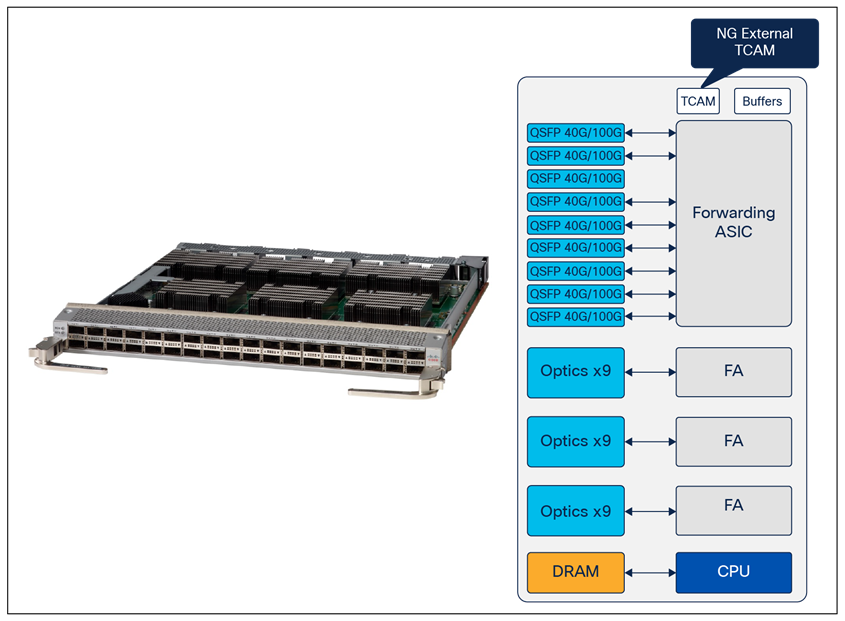
NCS 5500 36x 100G scale line card
It contains four Jericho+ forwarding ASICs, each offering 900 Gbps of bandwidth with 835 Mpps of throughput.
Table 16. NCS 5500 36x 100G scale line card specifications
| NC55-36X100-A-SE |
Specifications |
| Ports |
36x QSFP+QSFP28 Ports |
| Forwarding ASICs |
4 Forwarding ASICs x (900 Gbps bandwidth each) |
| Resources |
4M IPv4 Routes |
| Buffers |
16-MB On-chip Buffers 4-GB Off-chip Buffers |
| Packet Forwarding Rate |
Up to 3340 Mpps (4x 835 Mpps) |
| Forwarding Throughput |
3.6 Tbps |
NCS 5500 36x 100G MACsec Line Card
This line card is MACsec capable with 36x100G. This line card has six forwarding ASICs, each connected to three MACsec ASICs and each MACsec ASIC connected to two 100G ports. MACsec is a layer 2 IEEE 802.1AE standard for encrypting packets between two MACsec-capable routers. MACsec secures the data by encrypting the layer 2 (Ethernet) payload such that the cleartext data is not readable even with access to the physical media.
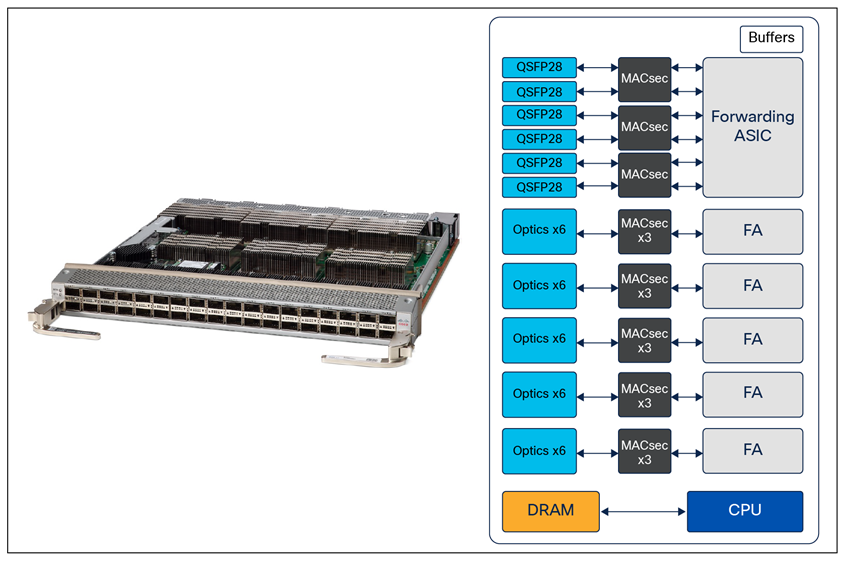
NCS 5500 36x 100G MACsec line card
It contains four Jericho+ forwarding ASICs, each offering 900 Gbps of bandwidth with 835 Mpps of throughput.
Table 17. NCS 5500 36x 100G scale line card specifications
| NC55-36X100-A-SE |
Specifications |
| Ports |
36x QSFP+QSFP28 Ports |
| Forwarding ASICs |
4 Forwarding ASICs x (900 Gbps bandwidth each) |
| Resources |
4M IPv4 Routes |
| Buffers |
16-MB On-chip Buffers 4-GB Off-chip Buffers |
| Packet Forwarding Rate |
Up to 3340 Mpps (4x 835 Mpps) |
| Forwarding Throughput |
3.6 Tbps |
NCS 5500 Modular Base and Scale Line Card
The modular line card is available in Base and Scale (-SE) versions. It offers a mix of fixed SFP and QSFP+ ports and modular MPAs (400 Gbps each) with MACsec encryption capability on all port types.
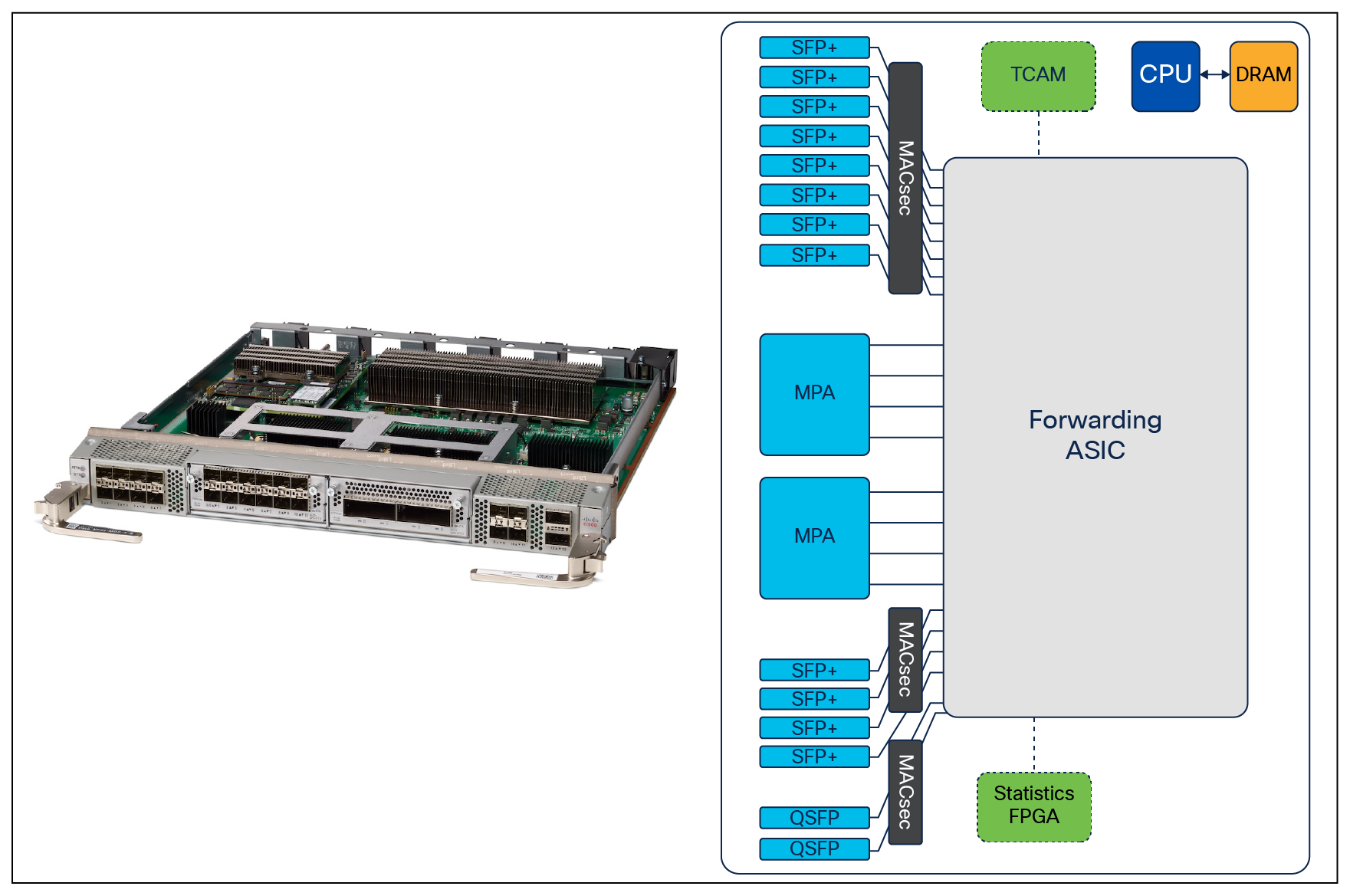
NCS 5500 MOD base and scale line card
It contains one Jericho+ forwarding ASIC, offering 900 Gbps of bandwidth with 835 Mpps of throughput.
Table 18. NCS 5500 MOD base and scale line card specifications
| NC55-MOD-A(-SE)-S |
Specifications |
| Ports |
12 SFP Ports, 2 QSFP+ Ports, 2 MPA 400G |
| Forwarding ASICs |
1 Forwarding ASICs x (600 Gbps bandwidth each) |
| MACsec Capability |
IEEE 802.1AE standards-based Layer 2 hop-by-hop line rate encryption on all ports |
| Resources |
350K + 784K IPv4 Routes (Base) 4M IPv4 Routes (Scale) |
| Buffers |
16-MB On-chip Buffers 4-GB Off-chip Buffers |
| Packet Forwarding Rate |
835 Mpps |
| Forwarding Throughput |
900 Gbps |
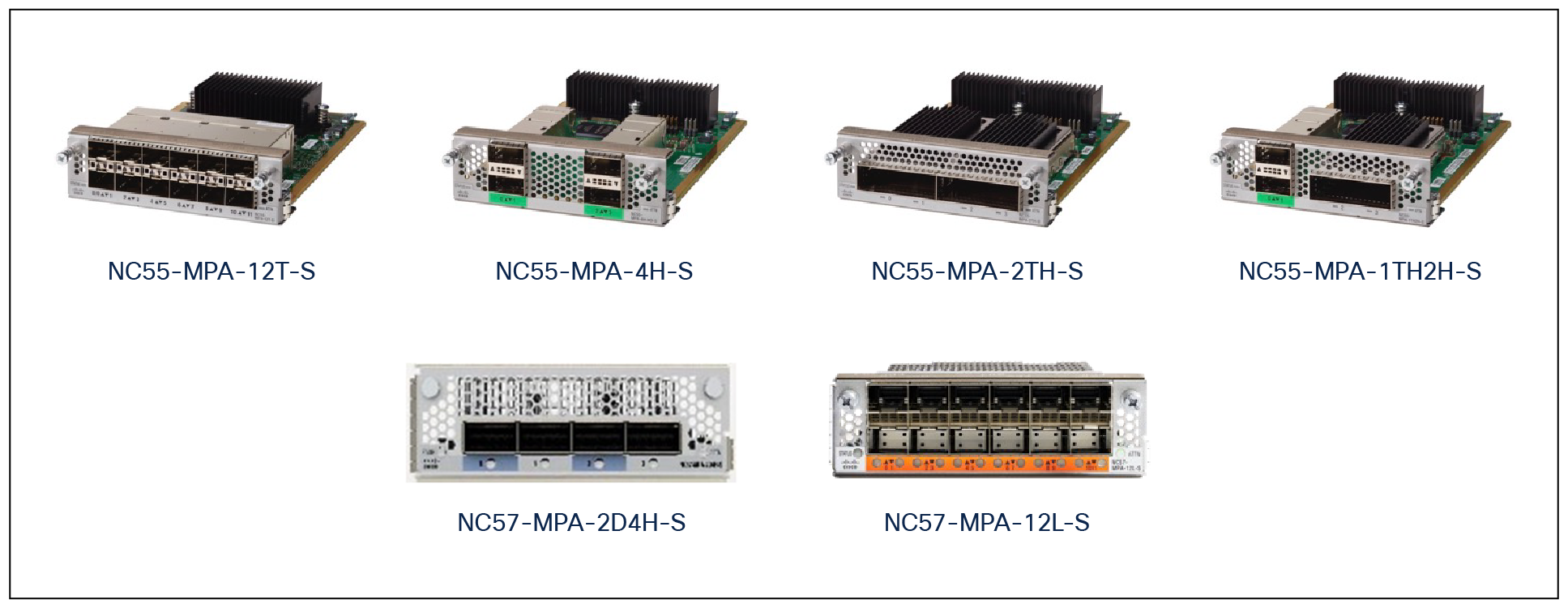
MPAs supported with NC55-MOD Base and Scale Line cards
NCS 5500 32x10G 16x25G 4x100G Base Line Card
The NCS 5500 32T16Q4H-A line card has 52 fixed ports: 32 ports of 1/10GE SFP/SFP+, 16 ports of 10/25GE SFP+/SFP28, and 4 ports of 40/100GE QSFP+/QSFP28.
Class C timing capable in combination with RP-2E

NCS 5500 32x10G 16x25G 4x100G base line card
Contains one Jericho+ forwarding ASIC, offering 900 Gbps of bandwidth with 835 Mpps of throughput.
Table 19. NCS 5500 32x10G 16x25G 4x100G base line card specifications
| NC55-32T16Q4H-A |
Specifications |
| Ports |
32x 1/10GE SFP/SFP+ 16x 10/25GE SFP+/SFP28 4x 40/100GE QSFP+/QSFP28 |
| Forwarding ASICs |
1 Forwarding ASIC (900 Gbps bandwidth) |
| Resources |
350K + 784K IPv4 Routes |
| Buffers |
16-MB On-chip Buffers 4-GB Off-chip Buffers |
| Packet Forwarding Rate |
835 Mpps |
| Forwarding Throughput |
900 Gbps |
For all the latest support on the NCS 5500/5700 modular platforms, please visit the following link:
https://tmgmatrix.cisco.com/?npf=20
The NCS 5500/5700 Series modular platforms offer a high density of 10/25/40/50/100/200/400G ports forwarding at line rates with low-latency forwarding and the lowest power consumption per Gigabit/sec for a fully loaded chassis.
The platform is highly reliable and resilient; its architecture is based on redundant route processors, system controllers, fan trays, fabric modules, and power supplies. The platform supports front-to-back airflow and platinum-rated 92% efficient power supplies; these, when combined with Cisco’s innovative orthogonal design, result in benefits such as efficient power and cooling, increased meantime between failures, and unrestricted scale for future growth. NCS 5500/5700 modular platform has base and scale models of line cards, giving network operators the flexibility to choose based on their density, scale, and cost needs. All line cards have on/off-ASIC buffers to provide deep queuing in case of network congestion. The NCS 5500/5700 modular platform runs on the Cisco IOS XR operating system. It is a 64-bit, Linux kernel-based, highly modular, and fully distributed operating system that provides a virtualized environment to independently run system administration and routing functions on separate virtual containers. The IOS XR software also offers features that enable innovations such as automation, telemetry, application hosting, and programmability.
Based on the hardware/software attributes and capabilities, NCS 5500/5700 is an ideal platform to position in data centers, large enterprise, Web and service provider’s WAN, Core and Aggregation networks to achieve efficient performance, highest density, and scale for growth.
Table 20. End-of-Sale Line Cards
| PIDs |
Description |
| NC55-24X100-SE |
NCS5500 24x100G Scale Line Card |
| NC55-36X100GE |
NCS5500 36x100G Base Line Card |
| NC55-24H12F |
NCS5500 24x100G + 12x40G Scale Line Card |
| NC55-18H18F |
NCS5500 18x100G + 18x40G Base Line Card |
| NC55-6X2H-DWDM-S |
NCS5500 6x200G Coherent Line Card |
| NC55-RP |
NCS5500 First-Generation Route Processor |
| NC55-5516-FC |
NCS5516 First-Generation Fabric Card |
| NC55-5516-FAN |
NCS5516 First-Generation Fan |
| New or Revised Topic |
Described In |
Date |
| NC55-RP-E photo update |
Figure 6 |
April 12, 2023 |
| Updated Power consumption |
Table 9, 10, 11, 12, 13 |
April 12, 2023 |
| MPAs supported on Line Cards |
Figure 26 and 30 |
April 12, 2023 |
| Timing support |
Table 8 |
April 12, 2023 |
| Added NC57-48Q2D Line Cards |
Table 14 and 15. Figure 27 and 28. |
Aug 21, 2023 |
[1] Is dependent on the type of line card.
[2]For 25G and 1G/10G, some restriction “per QUAD” may apply